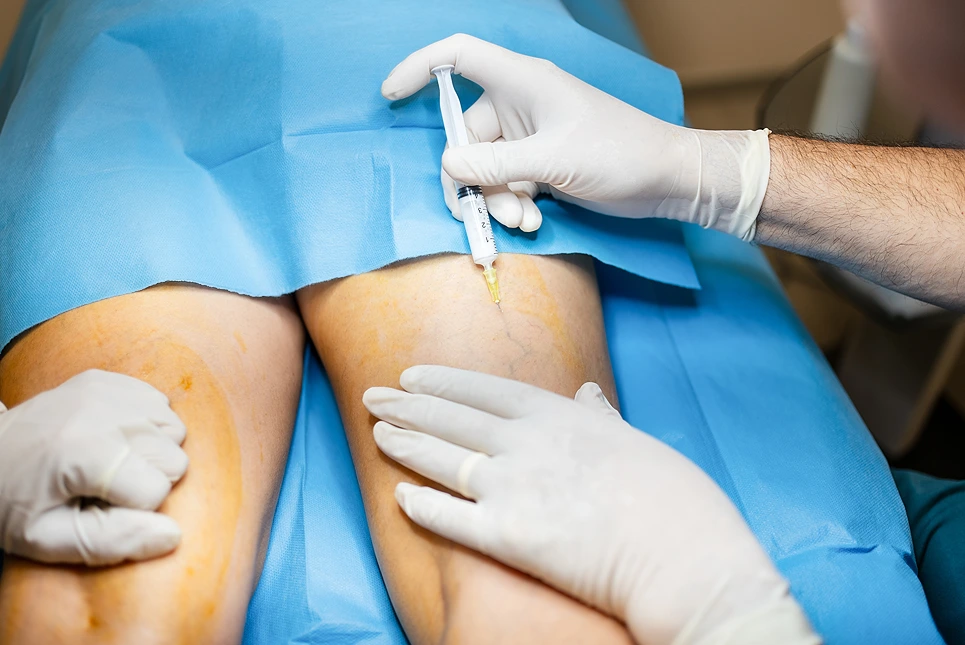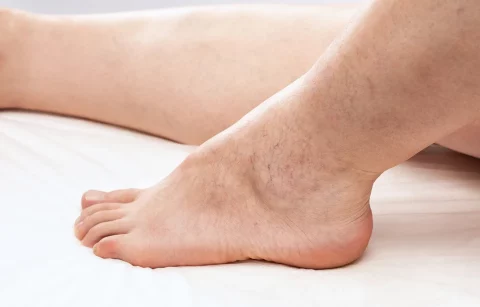Understanding these details can help you prepare financially while ensuring optimal outcomes for your spider veins.

Micro sclerotherapy offers a valuable option for treating spider veins, but it’s important to know what costs to expect.
Generally, you might pay $300 to $600 per session, depending on your provider and the treatment’s complexity. Multiple sessions are often necessary—typically 2 to 4—to achieve the best results.
Insurance usually doesn’t cover these expenses, making budgeting crucial. Plus, consultation fees range from $100 to $300.
Spider Veins: How to Assess the Extent and Location Before Treatment
Before undergoing micro sclerotherapy for spider veins, it’s essential to assess the extent and location of your condition. This step lays the groundwork for effective treatment, ensuring you get the best results possible.
Visual Inspection
- Start with a visual inspection of your skin. Look for the number, size, and color of spider veins.
- Smaller veins might require just one or two sessions, while larger ones could need four or more.
Location Matters
- The location of your spider veins is crucial. Veins on your legs often require different techniques than those on your face.
- A healthcare professional can help determine the best approach based on where the veins are located.
Document Progression
- Keep track of how your spider veins progress over time.
- Documenting changes can provide valuable insights for your treatment plan.
Consult a Professional
- Always consult a healthcare professional for a thorough assessment.
- They’ll tailor your treatment plan to your unique conditions, ensuring you’re on the right track to clear, beautiful skin.
Previous Vein Treatments: Does It Affect Your Micro Sclerotherapy Plan?

If you’ve undergone previous vein treatments, it’s important to consider how they might affect your micro sclerotherapy plan. Past treatments like laser therapy or traditional sclerotherapy can change the condition of your veins and how your skin responds to new treatments.
Here are a few key factors to keep in mind:
- Tailored Approach: You may need a customized plan, including adjustments in sclerosant concentration or session frequency, to achieve the best results.
- Treatment History: Documenting your past treatments helps your practitioner assess the best course of action and create a comprehensive treatment strategy.
- Impact on Costs and Sessions: The size and location of previously treated veins could influence the overall cost and the number of sessions required for effective micro sclerotherapy.
Choosing a Specialist or Clinic: What to Consider for Your Spider Vein Treatment
Look for a board-certified plastic surgeon or dermatologist who’s specific experience in vein treatments. This can significantly impact the safety and effectiveness of your results.
Research and Reviews Check the clinic’s credentials and read patient reviews. Success rates can offer valuable insights into the quality of care. Don’t hesitate to ask for before-and-after photos of previous patients to gauge their expertise.
Initial Consultation Use your initial consultation to discuss your treatment options, potential costs, and the number of sessions you’ll need. A personalized treatment plan is vital for achieving the best outcomes.
Transparency is Key Ensure the clinic provides transparent information on costs, including any additional fees. Also, verify if they accept your insurance plan and inquire about financing options to help manage out-of-pocket expenses.
How to Estimate Micro Sclerotherapy Costs Based on Your Provider
Prices for Micro Sclerotherapy can vary significantly based on several factors related to your provider.
Understanding these variables can help you make an informed decision and better plan your budget.
Here are three key factors that influence your costs:
- Provider’s Experience: More experienced specialists may charge higher fees due to their expertise and track record of successful treatments. Think of it as investing in quality care!
- Geographic Location: Costs can vary by region. Urban areas often have higher prices than rural locations, so consider this when selecting your provider.
- Complexity of the Procedure: If you have a larger number of veins or larger veins to treat, you may require more sessions, which can increase your total cost.
Additionally, don’t forget about potential consultation fees and follow-up appointments.
Does Insurance Cover Micro Sclerotherapy?

Insurance coverage for micro sclerotherapy can be tricky, as it’s generally considered a cosmetic procedure. Most health insurance plans don’t cover these costs, leaving you to potentially foot the bill yourself.
However, it’s not entirely black and white. Some insurance policies might cover micro sclerotherapy if you can prove medical necessity, especially for conditions like varicose veins. You may need to gather documentation from your healthcare provider to support your case.
Things to Consider:
- Prior Authorization: Some insurance providers require this before treatment, so check with your plan.
- Costs: Out-of-pocket expenses can range from $300 to $600 per session, depending on the number of veins treated and your provider’s fees.
Before proceeding, consult with your healthcare professional and your insurance company to clarify coverage options. It’s essential to understand the financial implications before committing to treatment.
How Many Sessions of Micro Sclerotherapy Will You Need?
Typically, you’ll need at least two sessions of micro sclerotherapy to see effective results, especially for smaller spider veins.
Some patients may notice satisfactory improvements after just one session, but for larger veins, you might require four or more treatments to achieve the best outcome.
Here’s a quick overview of what to expect regarding the number of sessions:
- Minimum Sessions: Most patients require at least two sessions for smaller veins.
- Larger Veins: If you have larger spider veins, you may need four or more sessions depending on their size and your individual response to treatment.
- Spacing: Sessions are often spaced several weeks apart to allow your body to absorb the treated veins and assess effectiveness.
Consultation Fees for Spider Vein Treatments: What to Expect
Consultation fees for spider vein treatments can range significantly, often falling between $100 and $300, depending on the provider’s expertise and the complexity of your evaluation. Some clinics even offer free initial consultations, allowing you to assess your options without any upfront costs.
What to Consider
Ask about consultation fees to avoid any surprises later. This initial visit is your chance to discuss treatment options, costs, and personalized care plans. Keep in mind that additional tests or evaluations may lead to extra charges.
| Provider Type | Typical Fee | Notes |
| Established Clinic | $200 – $300 | Highly experienced staff |
| New Practitioner | $100 – $150 | May offer promotional rates |
| Free Consultation | $0 | Limited time offers |
Make sure to clarify whether the consultation fee will be applied to the total treatment cost if you decide to proceed. Understanding these details upfront can help you feel more confident and prepared for your spider vein treatment journey.
Medical Conditions and Allergies: Can They Impact Your Treatment?

Your medical history and any allergies you’ve had can significantly influence your treatment plan.
Discuss these factors with your healthcare provider to ensure a safe and effective approach.
Here are three key considerations:
- Medical Conditions: If you have chronic venous insufficiency or clotting disorders, this may complicate your treatment. Your doctor might need to evaluate your condition further before proceeding.
- Allergies to Sclerosants: Allergies to common sclerosant solutions like polidocanol or sotradecol can lead to adverse reactions. If you have such allergies, your provider will likely consider alternative treatment options.
- History of Allergic Reactions: Inform your healthcare provider about any past allergic reactions to local anesthetics or medications. This ensures safe administration during your procedure.
Being open about your medical history and allergies allows your provider to tailor your treatment plan, maximizing your results while minimizing risks.
Payment Plans vs. Upfront Costs: Budgeting for Micro Sclerotherapy
Budgeting for micro sclerotherapy can often feel overwhelming, but understanding your payment options can make the process smoother. The typical cost ranges from $300 to $600 per session, depending on the veins treated. With many patients needing multiple sessions, planning ahead is crucial.
Upfront Costs
Before diving in, ask about any upfront costs. These can include consultation fees, treatment sessions, and even follow-up appointments. Knowing these figures helps you avoid surprises down the line.
Payment Plans
Many clinics offer payment plans that allow you to spread the cost over time. This can make micro sclerotherapy more financially manageable.
Consider financing options through medical credit companies, which provide tailored monthly payment plans to suit your budget.
Communicate
Always communicate openly with your healthcare provider about costs and payment options. Clear discussions can help you feel more confident and prepared as you navigate this process.
In the end, with proper planning and understanding, you can make micro sclerotherapy work for your budget.
Post-Treatment Care: What Additional Costs Should You Expect?

Post-treatment care is a crucial aspect of your journey with micro sclerotherapy, and it’s essential to be aware of the potential additional costs involved.
While the treatment itself can range from $300 to $400 per session, you should also consider other expenses that may arise during recovery.
Here are three key costs to keep in mind:
- Compression Garments: You might need to purchase these for proper healing, which can cost between $30 and $100 depending on the style and brand.
- Follow-up Appointments: Monitoring your progress is vital, and follow-up visits may incur additional charges, typically ranging from $50 to $150 each.
- Medications and Topical Treatments: Depending on your individual needs, prescribed medications can vary widely in cost, so be prepared for that as well.







